


Before we can use and write words correctly, it helps to know how to spell them. Although the English language is noted for its many variations in spelling and pronunciation, there are some basic guidelines that can be followed in the spelling of most words.
Now, you might think, what with spell checkers, grammar checkers, and automatic correcting features on today's electronic typewriters and computer word-processing programs, that you really don't need to know how to spell anymore; but you'd be wrong. Even the more advanced features of today's PCs can rarely tell you when a word you've spelled a correct way is not the correctly spelled word you intended.
And what about those words you need to know that don't happen to be in your computer's dictionary? -- Do you "skip" them? Do you "edit" them? Do you "add" them?
There's nothing more useless than a spell checker in which someone has added misspelled words!
Furthermore, frequently, a spell checker will give you a choice of various correct spellings. If you know what the word means but not how it's spelled, it's not going to do you much good in today's world of computer communications -- be it fancy word processing programs or simple text editors and e-mail (which often do not include spell-checking options!).
And even with a spell checker, the more words you don't know how to spell, the more times the spell checker will ask you:
--And the longer it will take you to complete your work!
Yes, we still need to know how to spell. So . . .
A syllable, you will remember, is one unit of sound. For example:
And so on.
The vowels and consonants that make up the word often have an effect upon how words are spelled. A vowel, as you may already know, is a sound made with an open mouth and throat. The common vowels are:
Sometimes these two letters are also used as vowels:
...as in the words:
and
The other letters of the alphabet are consonants. A consonant is a sound that more or less "breaks" sounds made with an open mouth and throat. For example, in the word "dog," you can hear the d "break" the sound at the beginning of the syllable and the g "break" the longer vowel sound at the end of the syllable. You can hold the vowel sound for as long as you like, but the consonant sounds (generally) cannot be held:
(Now, you might interrupt to ask what we meant by "generally" in the previous paragraph, but we'd just tell you: Shhhh!) And, before we forget, we should point out that the two letters...
are frequently used as consonants, as in the words...
and
...for example.
The English language often takes so-called "root words" and adds syllables to them to make new words. You note things today. You noted things yesterday. These things were very notable.
To change from present tense (today) to past tense (yesterday), you added the ending "ed" to the word note. To make the word note describe something (used as an adjective), you added the ending "able" to note.
But you noted the spelling of the root word note changes when you added ed and when you added able (didn't you?). But how do we remember when and how spellings of root words change when adding endings to them? -- We use spelling guides....
and
and
That is, double the final consonant when the word ends in only one vowel followed by only one consonant and the ending begins with (or is) a vowel.
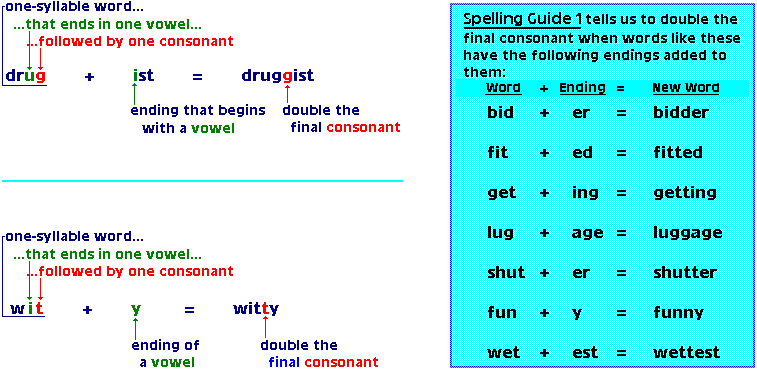
The reason for Spelling Guide 1 is really very simple. Consider what happens to a one-syllable word that ends in one vowel followed by one consonant when another vowel is added after it:
The short vowel sound in quit becomes long in quite.
There is no need to double the final consonant of the root word when the ending to be added will not change the word's original vowel sound.
Here are some more, similar examples:
None of the above endings changed the original vowel sound of the above root words. Therefore, there was no need to double the final consonant of the root word. Can you see how none of these root words fits the criteria of Spelling Guide 1?
Here's one more example of the reason behind Spelling Guide 1:
If we didn't follow Spelling Guide 1, we'd get:
Consider the difference between the following two sentences:

Now, aren't you glad we have this spelling guide?
Did you notice under "Reasoning behind Spelling Guide 1," above that Spelling Guide 1 also tells us when not to double the final consonant of a root? In fact, it tells us three times not to double the final consonant. Let's take another look Spelling Guide 1 and its Three Nots. . .
That is, do not double the final consonant when the word ends in more than one consonant . . .
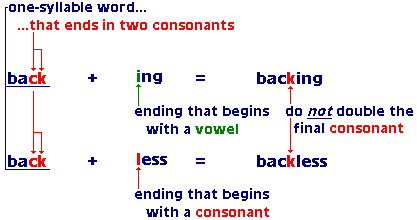
That is, do not double the final consonant when the word ends in more than one vowel followed by a consonant . . .
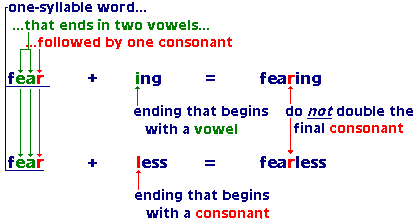
That is, do not double the final consonant when the ending begins with (or is) a consonant . . .
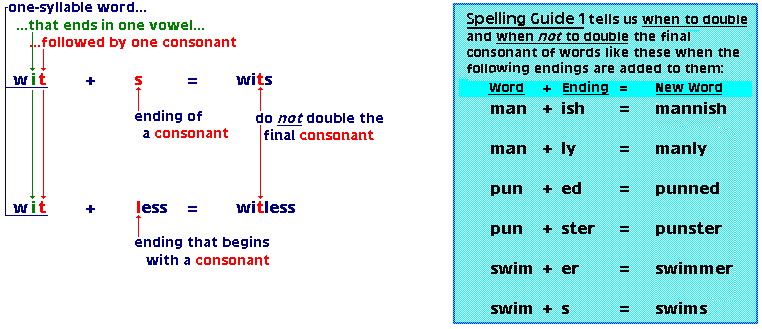
The letters x and q can be spelling troublemakers. At first glance, some words with the letter x and some words with the letter combination qu don't seem to follow Spelling Guide 1. But remember the reason behind Spelling Guide 1: the sound of the word.
The letter x makes the same sound as the letter combination ks. Treat root words that end in x as if they ended in two consonants:
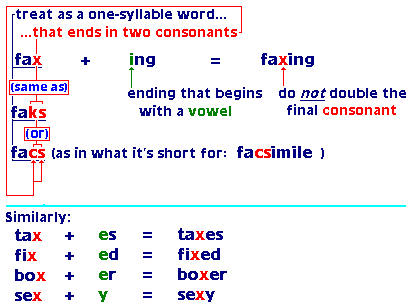
The letter combination qu makes the same sound as the letter k (or "hard c") followed by the consonant sound of the letter w: kw. Treat words that begin with qu as words beginning with two consonants, not as words with two or more vowels.
For example, the word "quit" is treated as a word with one vowel before the final consonant: the i is the vowel; the qu is treated as if it were kw:
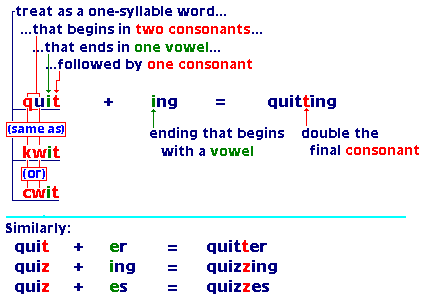
We have three more troublemakers to talk about here. First of all, Spelling Guide 1 might lead us to conclude that, when adding an ending beginning with a vowel to a word like "saw," (a root word that ends in one vowel apparently followed by one consonant), you should double the final consonant; but you don't. Can you guess why not?
Did you figure out why you don't double the w when adding an ending beginning with a vowel to a word such as "saw" (that apparently ends in one vowel followed by one consonant)? Did you remember we said earlier that the letter w is sometimes pronounced as a vowel?
In words that end with a w, the w is being used as a vowel. If you don't believe this, well, POW to you! Sorry; don't POUT. The only difference between the sounds of these two words is the consonant t at the end. Treat words that end in w as words that end in two vowels:
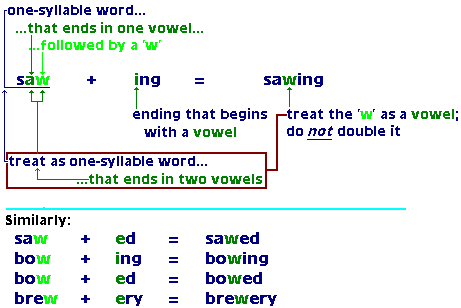
The ending "ness" can be a troublemaker when added to a root that already ends in the letter n. Remember, you are not doubling the n. It just happens that the root ends in n and the ending begins with n. You should keep both n's in such words:
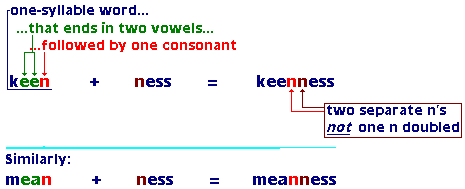
Adding the ending "ly" to a word doesn't have anything to do with Spelling Guide 1. However, we noted above that adding the ending "ness" to a root word already ending in n should not deter us from using both n's -- the one in the root and the one in the ending. This might suggest that adding any ending that begins with the same consonant as the last consonant of the root word requires keeping both consonants. But it doesn't apply when the last two consonants of the root word are the same.
Thus, when we add the ending "ly" to a word that already ends in two l's, we do not keep all three l's. We say we "drop" the final l of the root and add l y:
![]()
The following "Study Words" illustrate Spelling Guide 1. Study their spellings; but also use a full-size dictionary to look up each word, even if you think you know each word's meaning and pronunciation. You may well be surprised at the number of definitions some of these words have -- many of which you may not think of when you first see the word. And don't be afraid to take notes! This is the beginning of your vocabulary building!